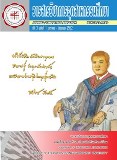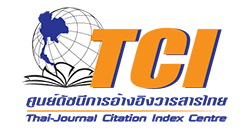การพัฒนาหลักสูตรฝึกอบรมด้านการทดสอบทางประสาทสัมผัส สำหรับตรวจสอบคุณภาพเบื้องต้น
Abstract
บทคัดย่อ การวิจัยนี้มีจุดมุ่งหมายเพื่อศึกษาการพัฒนาหลักสูตรฝึกอบรมด้านการทดสอบทางประสาทสัมผัส สำหรับตรวจสอบคุณภาพเบื้องต้น ของ บริษัทโฟร์โมสต์ ฟรีสแลนด์ (ประเทศไทย) จำกัด (มหาชน) มีขั้นตอนในการดำเนินการวิจัย 3 ขั้นตอน ดังนี้ ขั้นตอนที่ 1 ขั้นตอนรวบรวมข้อมูล โดยศึกษาเอกสารที่เกี่ยวข้องจากหลักสูตรที่ใช้อยู่เดิมในด้านเนื้อหาหลักสูตรและกระบวนการฝึกอบรม เพื่อนำมาใช้กำหนดกรอบปัญหาในแต่ละด้านของการฝึกอบรมด้านการทดสอบทางประสาทสัมผัส สำหรับตรวจสอลคุณภาพเบื้องต้นและนำข้อมูลที่ได้มาใช้ในการพัฒนาหลักสูตร วิเคราะห์จัดลำดับความสำคัญของปัญหาที่เกิดขึ้นในการฝึกอบรม เพื่อนำข้อมูลที่ได้มาวาวแผนเพื่อกำหนดโครงสร้างหลักสูตร จุดประสวค์เนื้อหาสาระของวิชาในหลักสูตรตามลำดับความสำคัญ ขั้นตอนที่ 2 ขั้นของการดำเนินการพัฒนาหลักสูตร หลังจากในขั้นตอนที่ 1นั้นจะให้ผู้ทรงคุณวุฒิและผู้เชี่ยวชาญในการตรวจสอบหลักสูตรทำการตรวจสอบหลักสูตร ซึ่งผู้เชี่ยวชาญที่ใช้ในการตรวจสอบหลักสูตรมีทั้งหมด 3 ด้าน ประกอบด้วยผู้เชี่ยวชาญในด้านการพัฒนาหลักสูตร ผู้เชี่ยวชาญในด้านการทดสอบทางประสาทสัมผัส ผู้เชี่ยวชาญในด้านการวิเคราะห์ด้วยประสาทสัมผัสและทำการแก้ไขตามคำแนะนำของผู้ทรงคุณวุฒิและผู้เชี่ยวชาญ ขั้นตอนนี้จะเป็นขั้นการดำเนินการพัฒนาหลักสูตรซึ่งกระบวนการที่จะใช้นี้จะนำเทคนิคการฝึกอบรมมาใช้โดยจะเน้นการให้ความรู้จากการบรรยาย โดยวิทยากรผู้มีความรู้และความชำนาญในแต่ละด้านรวมถึงมีการแบ่งกลุ่ม เพื่อให้ผู้เข้าฝึกอบรมได้อภิปรายในแต่ละเรื่องของปัญหา ขั้นตอนที่ 3 ขั้นดำเนินการประเมินผลหลักสูตร ในส่วนที่สามนี้จะเป็นขั้นการดำเนินการประเมินผลการใช้หลักสูตร ซึ่งลักษณะการประเมินผลจะใช้วิธีการประเมินผลระหว่างการฝึกอบรมและหลังการฝึกอบรมโดยใช้เกณฑ์ 90/90 ซึ่งจากผลท่ได้พบว่าหลักสูตรฝึกอบรมด้านการทดสอบทางประสาทสัมผัสทั้ง 5 ด้าน คิดเป็นร้อยละ 99.53 ซึ่งมีประสิทธิภาพสูงกว่าเกณฑ์ 90/90 และเป็นไปตามสมมติฐานที่ตั้งไว้. คำสำคัญ : การพัฒนาหลักสูตรฝึกอบรม การทดสอบทางประสาทสัมผัส Abstract The purpose of this thesis was to developed a curriculum on sensory evaluation training program for product quality inspection of Foremost Friesland (Thailand) Public Company Limited. The procedure was divided into three parts. First : Study and gather information Study and review the relevant documents of the existing curriculum and training process; this is to define the range of problem of each area of sensory evaluation training, and to test product quality and bring back the result to help develop the curriculum. Analyzing and ordering the importance of the problem occurring in the training was conducted so as to use the result from the process to plan in order to define the structure, goals and content of curriculum according to the importance. Second : Curriculum development. This step was about applying the curriculum. After that, the curriculum would be looked over by the professional agents. There existed 3 areas in the inspector of curriculum, namely, professional agents in curriculum development, in sensory test and in analyze by using sensation. Thus, this was correct in the way that professional agents had suggested. The process to be applied would bring the training techniques in; it would highlight on the sharing knowledge from the lecture from professional agents in each area, after so the trainees were formed into groups so that they could make the discussion in each topic of the problem. Third : The evaluation of the curriculum development. This step related to the operation of the curriculum after it had been actually used. The population and sample group were the same as in the second step. The evaluation was conducted during the period of training and after the training period as well; the standard was set at 90/90 because this can indicate the progress of trainees and thus the curriculum. According to the result, curriculum of sensory evaluation training program is above the standard of 90/90 and the hypothesis is accepted. Keyword : Curriculum Development, Sensory EvaluationDownloads
Download data is not yet available.
Downloads
Published
2009-07-01
Issue
Section
บทความวิจัย




